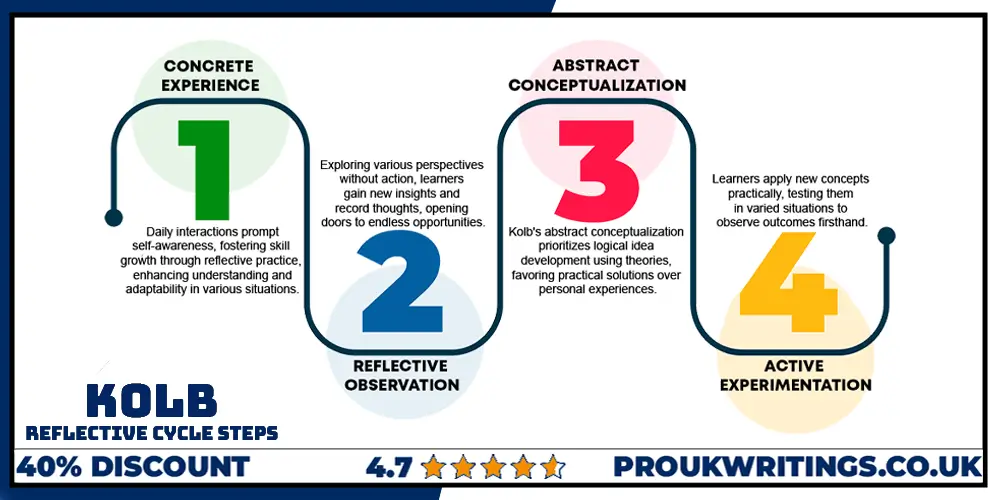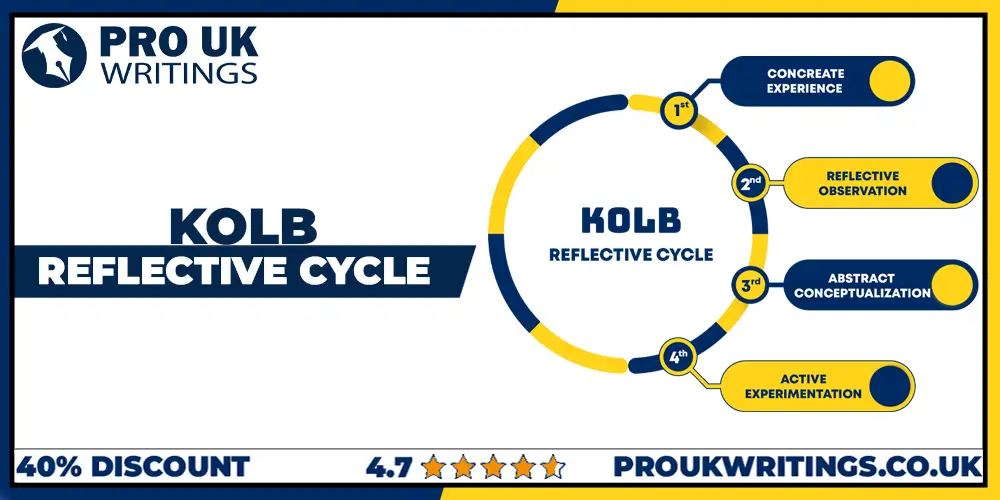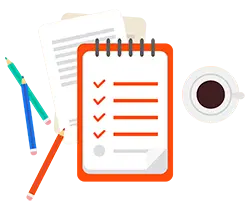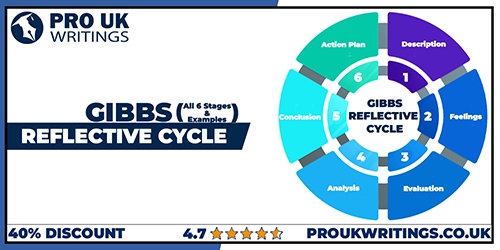Kolb’s Model Of Reflective Cycle:
In 1984 David Kolb published his style of learning from which he developed his style directory his variation of the reflective model has been named “Experiential Learning” also known as “Kolb Reflective Cycle”.
The purpose of putting this reflective model into execution is to do things we experience in our practical life then retrospect them observe and verdict the appraisal in 4 distinguished stages.
What Is Kolb’s Cycle Of Learning?
Humans are very fascinating creatures of God their ability to examine and process things. This cycle of learning sets them apart from other beings their ability to experience expands their cognitive ability over the past few decades and a period of an impressive amount of time. This phenomenon has been studied and explained by many that how a human brain works through the form of reflective models and out of the many the most exceptional and influential model was brought by David Kolb which is commonly known as the “Experiential Model” (ELT) in abbreviation form which stands for “Experiential Learning Theory” in 1984.
This model has very commonly been used worldwide but the theoretical concept for this model inclines to presuppositions that individuals ascertain by their actions or from more practically assertive experiences.
Direct teaching of information is a negating way of education. The pedagogical approach is more effective because now we are in a much firmer state of fastidiously choosing ways of teaching educational programs, it does not matter whichever level of the educational grade you assist in implementing a pedagogical model into your teaching which helps us to alter our experiences into knowledge is crucially significant to atone student’s progress.
How Kolb’s Experiential Learning Cycle Is Beneficial?
Experiential learning theory has been conducive for individuals in the process of intaking information through means of real-life experience reflections aside from educational learning preferences. Kolb’s reflective model has proven to be significant in terms of jobs or internships for conventional programs and development professionals but under the circumstances of constant development in technology gadgets and advances in communicational techs and (MOOCs) Massive Open Online Courses advent of higher education system intends to go for more “Experiential Learning Techniques” competency-based degrees are one good example of today’s world where students have to drive competence from real-world experiences.
Also read: Critical Analysis Of A Research paper
What is the difference between Experiential, Conventional & Didactic Learning?
Kolb Learning Cycle of 1984 is used fundamentally as one of the most useful learning styles for acquiring new knowledge. Kolb’s reflective model concentrates on the practitioner’s ascending stature in terms of self-growth and expanding point of view which is different from conventional and didactic learning in this type of learning process an individual is responsible for mandating his learning process Kolb’s reflective model is used in a leaden manner in academic projects by students because it allows students to apply their knowledge in real life circumstances practically.
Active Participation, Critical Thinking, Generating avant-garde ideas, coming up with solutions for problems, contributing to life on a personal scale and Communication Skills are all encouraged in Experiential Learning.
Whereas conventional and didactic methods are consisted of lectures, textbooks, homework and assignment these methods are incredible with the teaching of facts and clearing up the concepts but not necessarily how to apply them in real time in practical situations.
Both of these methods are good and essentially significant in their ways for distinguished purposes and also perform well in different styles of teaching there is no contradiction that experiential learning is superlative when it comes to retaining new information in student’s knowledge.
Also read: How, Why, When, and Who Invented Homework?
How Kolb’s Learning Cycle Is Helpful To Students?
For you to comprehend How the Kolb Reflective Model help students to retain knowledge and expand it here are a few steps to give you an insight:
- Familiarisation: Students come in alignment with the subject matter through real-life practical experiences and reflect them into their learning.
- Being Cognisant Of: To ascend their stature in the educational system students intricate themselves deep into the following aspects.
- Restoration: Students recall the past and retrieve the circumstances that already happened.
- Unification: Students strongly acknowledge the new information and retain it for a long time.
- Assessing Process: Whether the experience was worth it or not students evaluate it.
- Merge: Students add in the new information along with the already existing information.
- Execution: Students apply the newly learnt didactics to come up with solutions for the problems.
- Further Wandering: Students do not end it there they continue to hunt for new knowledge.
Kolb Reflective Cycle is interesting right?
What Is The Purpose Of Kolb’s Reflective Model?
David Kolb who came up with the model of Kolb’s reflective model of experiential learning theory in 1984 delivers the speculation of individuality among human beings each of them having different learning styles model depending upon their personal experiences of life encompassment genetics analysis and the idea of past, present & future. In Kolb’s perspective a person goes through swivelled intricacies of life choices, worries and experiences which ends up in a final settlement & analysis of the experiences.
These reflections are then formed into abstract concepts with past knowledge and then given a new meaning into theories or abstract ideas which leads to implying actions in such ways that are completely different from the ones in the past which makes them settle to the experience that can be explored and tested.
His model of the Kolb Reflective Cycle is a pedagogical approach which he used at Stanford University to bring new information into his student’s knowledge through which he did accomplish his aim of self-directed study because he wanted his students to be their problem solvers.
Also read: Emotive Language : Explanation, Uses, & Examples!

4 Stages Of Kolb Reflective Cycle
The reflective cycle of David Kolb consists of 4-stages of the effective learning process in which an individual touches The reflective roots of all four crucial steps that go into the model i.e. concrete learning, reflective observation, abstract conceptualisation and active experimentation these are the 4 key stages of the model but what exactly are they? Let’s dive in and find out.
CONCRETE EXPERIENCE:
On an everyday basis how a person interacts with others and displays their involvement with others get examined because one person is constantly feeling and experiencing something in the ambience consciously and physically which makes them understand to systematically reflect which makes them comprehensive of new skill approaches or improve their existing skills which they are in status quo practising being in this stage make a note out of a particular situation with an interpretation of what you had experienced with this specific situation.
REFLECTIVE OBSERVATION:
Seeing one situation from many different points of view opens doors to endless opportunities and this is precisely what one does at this stage they comprehend the situation and ideas from many different perspectives the learner gets a new perspective of the same situation out of making verdict about it but make sure to not essentially execute any act learners write down their narration based off of their feelings and musings.
ABSTRACT CONCEPTUALISATION:
The main objective of reflection in models is to shine light on new ideas creatively or to modify an old abstract through logical approach, ideas and theories instead of utilizing personal feelings, dilemmas or experiences abstract conceptualization of the Kolb model is more of a practically logical approach to have an insight of the circumstances where systematic planning and building practical solutions for situations are also helpful in this process.
ACTIVE EXPERIMENTATION:
At this stage the learners execute the newly made or modified concepts into experimentation at the active stage active learners experience new aspects by experiments with different situations at this stage the practical approach is exalted which is different from analysis individuals apply their ideas and put them out into the world to examine which consequences take place.
These are the 4 key stages of David Kolbd’s model of reflection.
For any type of service and Blog information Pro UK Writings have always exceeded all expectations now that you know all about David Kolb’s model of reflection make sure to also read Gibb’s reflective model & Rolf et. al model.

Sebastian James
Blog Author
Meet Mister Sebastian James who is an accomplished academic writer, who holds great credentials in various different faculties of academic writing having the degree of doctorates. Mr. Sebastian James is the original author all of the content written on this website with great knowledge of academics Mr. Sebastian James is the original upfront writer for Pro UK Writings.
FAQs
Find Solutions of your queries
Kolb’s reflective model is a model of reflection established by David Kolb in 1984 and has exclusively been designed to assist individuals in inclusive fields as it allows them to reflect on their experiences and be creative for future possibilities.
Here are the 4 stages of Kolb’s Reflective Cycle
- (CE) stands for Concrete Experience
- (RO) stands for Reflective Observation
- (AC) stands for Abstract Conceptualization
- (AE) stands for Active Experimentation
Kolb’s model of self-reflection is advantageous for self-atonement and growth this is the main objective that had been kept in mind while creating this model.
John Dewey’s claim that “learning must be grounded in experience” was the inspiration behind David Kolb’s intention of coming up with an effective way of learning new information which he did reach for success because his model is among the best ones.
If the process is not done with meticulousness and the right procedure then it may lead to false conclusions for the situation or problems in practical life or inappropriate solutions for the situations in academic writing.
The 2 dimensions that go into the Kolb model of reflection are comprehension and process these 2 steps have been bifurcated into 2 categories of each:
- How a person comprehends the information the understanding of their experiences has been classified into the 2 stages of the model concrete experience and abstract conceptualisation.
- This is the second stage of the dimension where the process takes place to process active information this dimension has been divided into other 2 stages. The reflective observation stage and active experimentation.






